Living Lab: Chapman Community Teaching Garden
By Laura Lukes
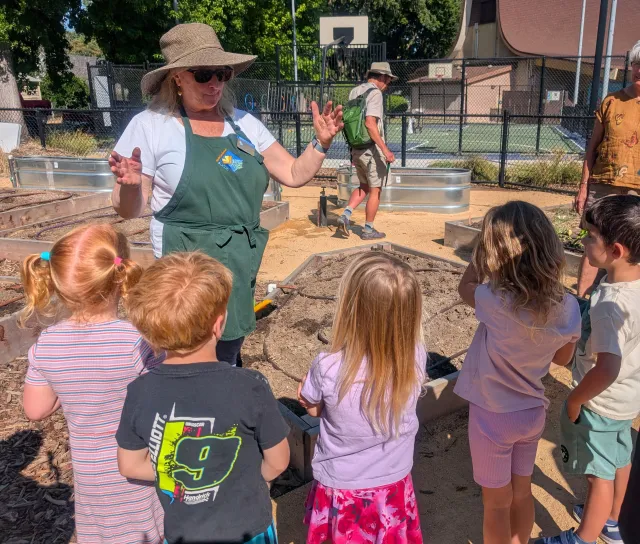
“Living Lab” is the perfect name for an innovative outdoor learning and teacher-training program that just might change a child’s life. Our Master Gardeners (MGs) Living Lab team offers a number of resources for local schools. This article focuses on our collaboration with the Chico Area Recreation District (CARD) in their 2025 Summer Camp for children ages three to five. Spoiler alert: you are going to want to sign your child up for the 2026 program!
In 2024, CARD and the MGs worked together to design and build the versatile Community Teaching Garden in Chapman Park. The partnership included the creation of Living Lab in the Garden curricula for the kids ages three to five enrolled in four of CARD’s 2025 Summer Camps. Each of the week-long camps in June and July had a different theme and up to 16 campers; each group of campers spent one hour of their week on theme-based educational garden activities led by the MG Living Lab Team.
The hands-on lessons were designed to capture and hold the kids’ attention while teaching them the basics of plant biology, soil science, and fresh food, plus just how to have fun with all things plant-related. Groups of three to four children rotated through four activity stations led by MGs; each station had 15 minutes to inspire and educate – just the right amount of time to hold a preschooler’s interest. The joy on the kids’ faces, the palpable excitement as they shifted from station to station, and their eager questions proved that learning in the Garden is fun. In all of the lessons, children were encouraged to share their existing knowledge and fire away with their questions.
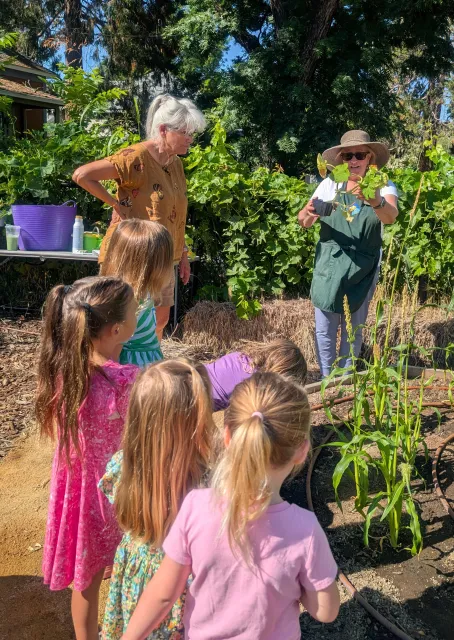
Camp One: Science, Technology, Education, Arts, and Mathematics (STEAM)
Our first STEAM Camp station had the kids digging in the Three Sisters garden bed, where they transplanted pumpkin starts to accompany the existing corn and bean plants, an activity that demonstrated and was accompanied by a story about Native Americans’ use of the Three Sisters companion planting methods. In a different garden bed (Station 2), they enjoyed more time in the soil planting seeds for bush beans and nasturtiums while learning about what seeds need to sprout and thrive (healthy soil, water, and sun). At Station 3 it was time for art! With a clever combination of construction paper, clothespins, pipe cleaners, paper scraps, and glue, each child created a butterfly while learning a bit about these important and beautiful pollinators. The final station focused on exploring the value of herbs as ways to enliven food. Easy to grow herbs (mint, basil, cilantro, lavender, lemon verbena, bay leaf, and chives) were discussed, cut, and rubbed to release and appreciate their aromas.
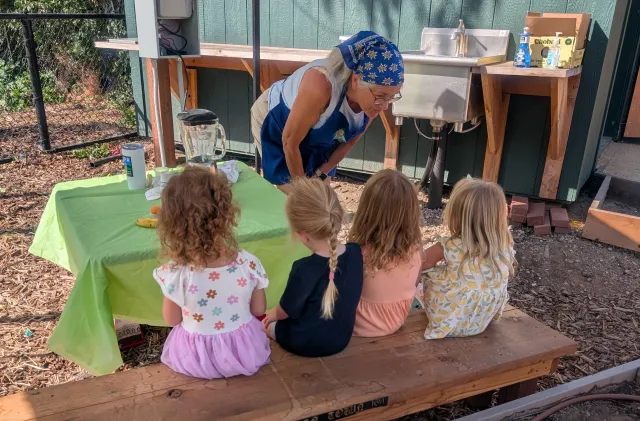
Camp Two: Mini-Chefs
The following week, four discrete yet complementary lessons were designed for Mini-Chefs. Our Community Garden buildout included an outdoor kitchen, used to demonstrate and practice ways that garden produce can be prepared and eaten. Our first station had kids identifying fruits and how they grew (on trees? On vines?), along with their nutritional value. The brightly colored berries were then blended, along with bananas, into delicious smoothies to enjoy on the spot. Making healthy salads was the focus of Station 2. Here, MG leaders had prepped a large variety of salad veggies (lettuce, tomato, carrot, bell peppers, sugar peas, etc.) that each child could mix into their own container. After having a look at our sunflower and grape plants, the Mini-Chefs at the third station prepared a nice batch of trail mix that included raisins (from grapes!) and sunflower seeds, along with other seeds and nuts. Pickles were made at Station 4, while discussing the value of ways to preserve fresh foods. Kids filled their containers with pre-sliced cucumbers, then added vinegar, sugar, some picking spices, and salt. They could take this home, then wait three days to enjoy their camp-made pickles.
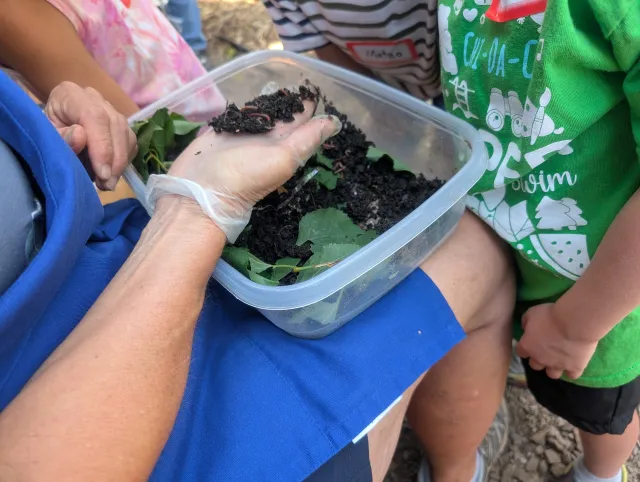
Camp Three: Flowers and Worms
The irresistible combination of Flowers and Worms was the focus of the following week’s Camp. The first activity took place in the compost area of the Community Garden, where kids created their own worm compost mini bin to take home. Soil, some food scraps, and a handful of worms were used to teach the science of vermiculture. (Worms eat dead plants and food waste and turn it into compost by “casting” – pooping – it out. This was a big hit of course). The second lesson had kids transplanting a selection of flower starts such as sunflowers, marigolds, and salvias to various beds within the Garden, taking care to tuck them in firmly and water them well while learning why those actions were necessary to the health of a plant. More planting took place in the third teaching activity, when the kids planted their own seed in a small pot to take home and watch grow. In the final lesson that week, each camper used a variety of materials to create a cross-section model of a healthy plant on paper, from its roots in the soil to its bloom above ground, including a worm or two beneath the soil surface. Because, of course, what is underground is critical to the growth and development of the beauty above the ground.
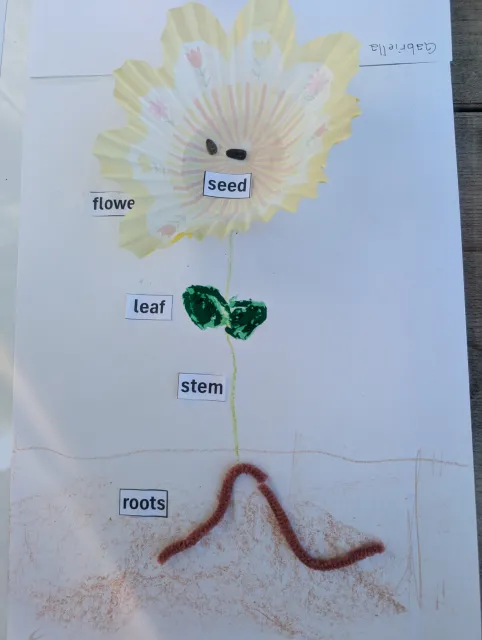
Camp Four: Art in the Park Camp
Our final session with the young CARD campers was all about the arts: drawing, creating leaf art, making a seed collage, and singing. Kids employed oil pastels, watercolors, and pencils at Station 1 to draw and paint the still life of flowers in a vase in front of them. Leaves and crayons were the supplies provided in the second station to transfer the patterns of various leaves to paper, using the rubbing method. Creating a collage of their choice by gluing many different seeds to paper was the focus of Station 3. The final activity was a hearty group sing-along to garden songs from the Banana Slugs String Band.
Thanks to the Living Lab Team members Joyce Hill, Candice Boggs, Mary Wrysinski, Marie Dillon, Toni Morucci, Joannie Ellison, Barbara Vogt, Diana Hoffmeister, Rick Rogers, Konnie Marskey, and Mary Jacobsen for their creativity and dedication to the program and to the children. What happens when you get kids outside with their hands in the dirt, under the direction of talented and creative leaders, is nothing short of inspirational, and a lot of fun to boot. (Maybe even life changing.) If you’ve got young ones, sign them up!
UC Master Gardeners of Butte County are part of the University of California Cooperative Extension (UCCE) system. To learn more about us and our upcoming events, and for help with gardening in our area visit our website. If you have a gardening question or problem, email the Hotline at mgbutte@ucanr.edu or leave a phone message on our Hotline at 530-552-5812. To speak to a Master Gardener about a gardening issue, or to drop by the MG office during Hotline hours, see the most current information on our Ask Us section of our website.
